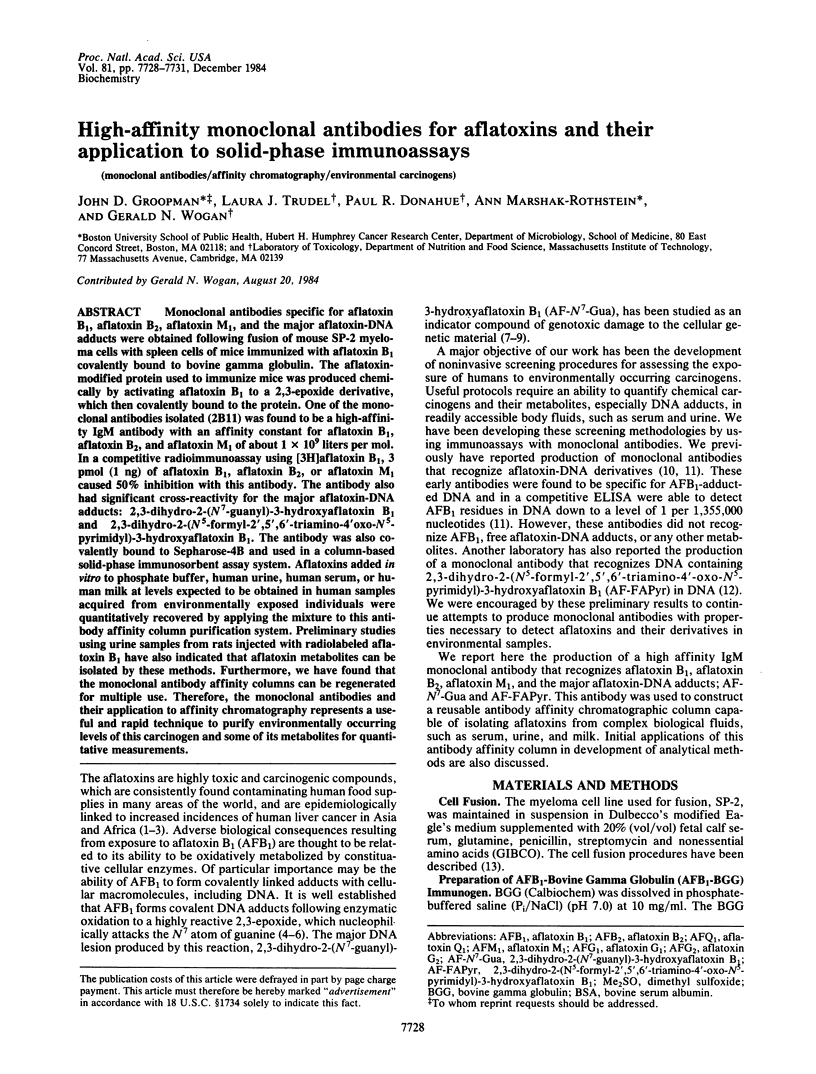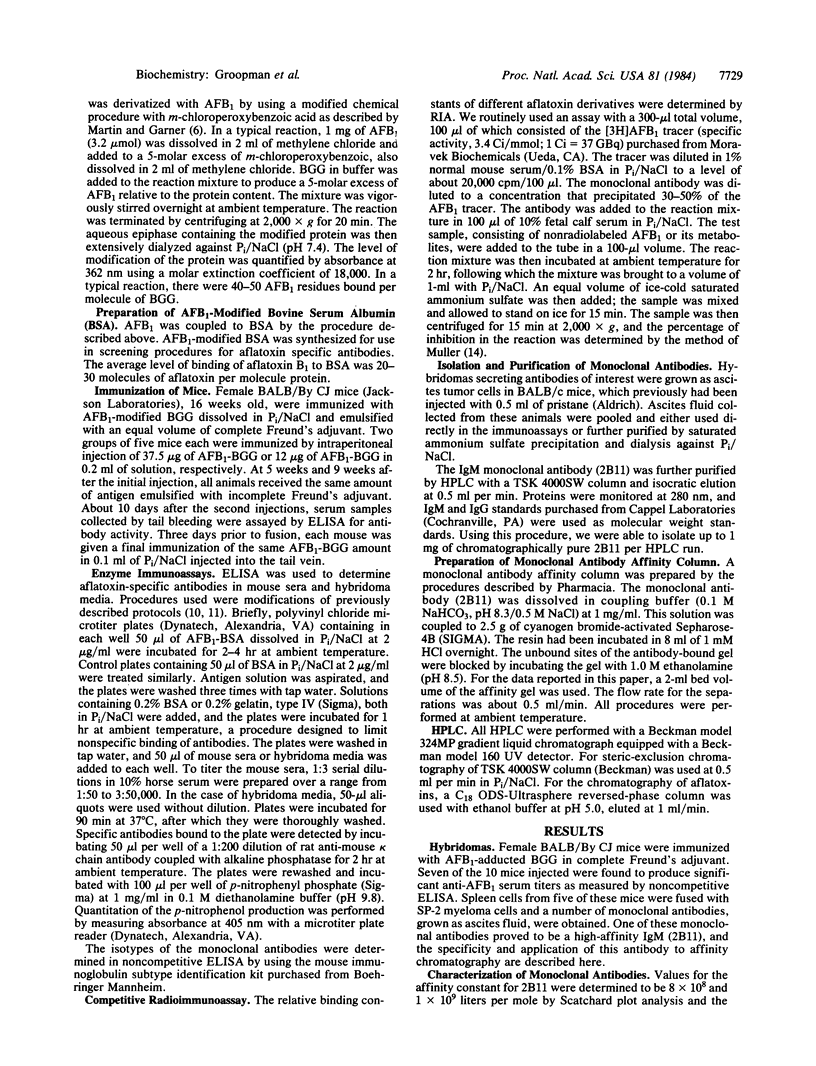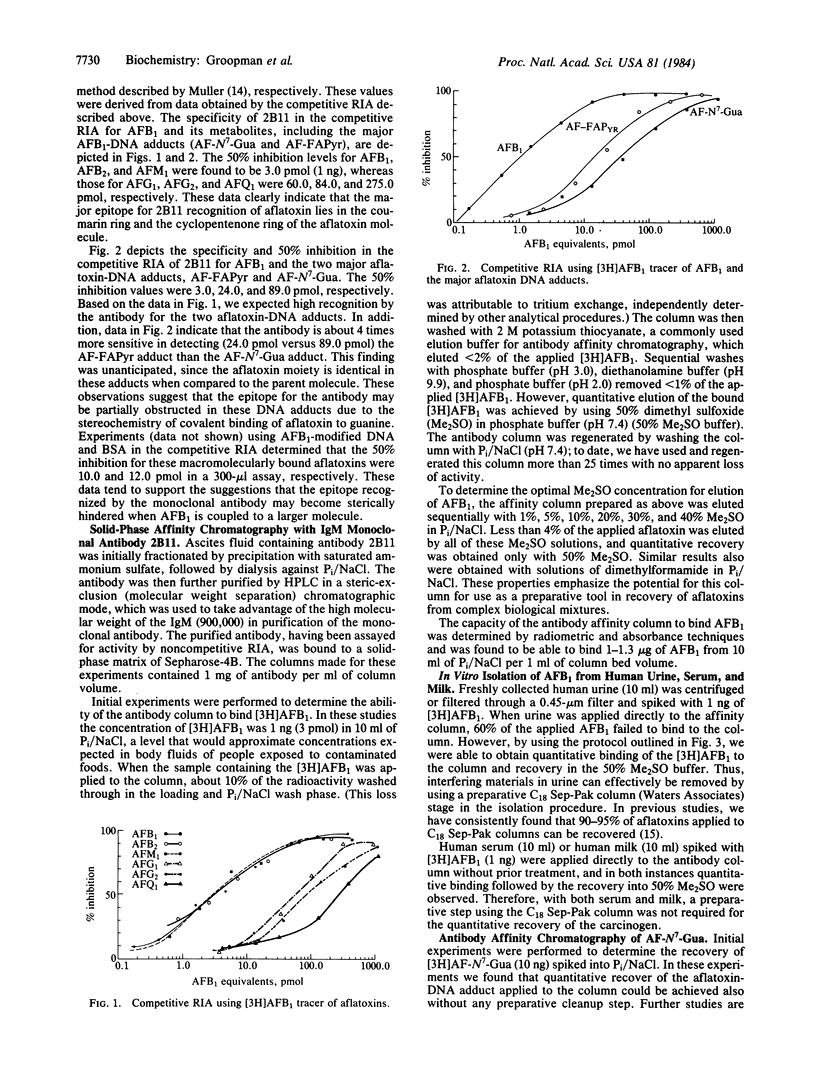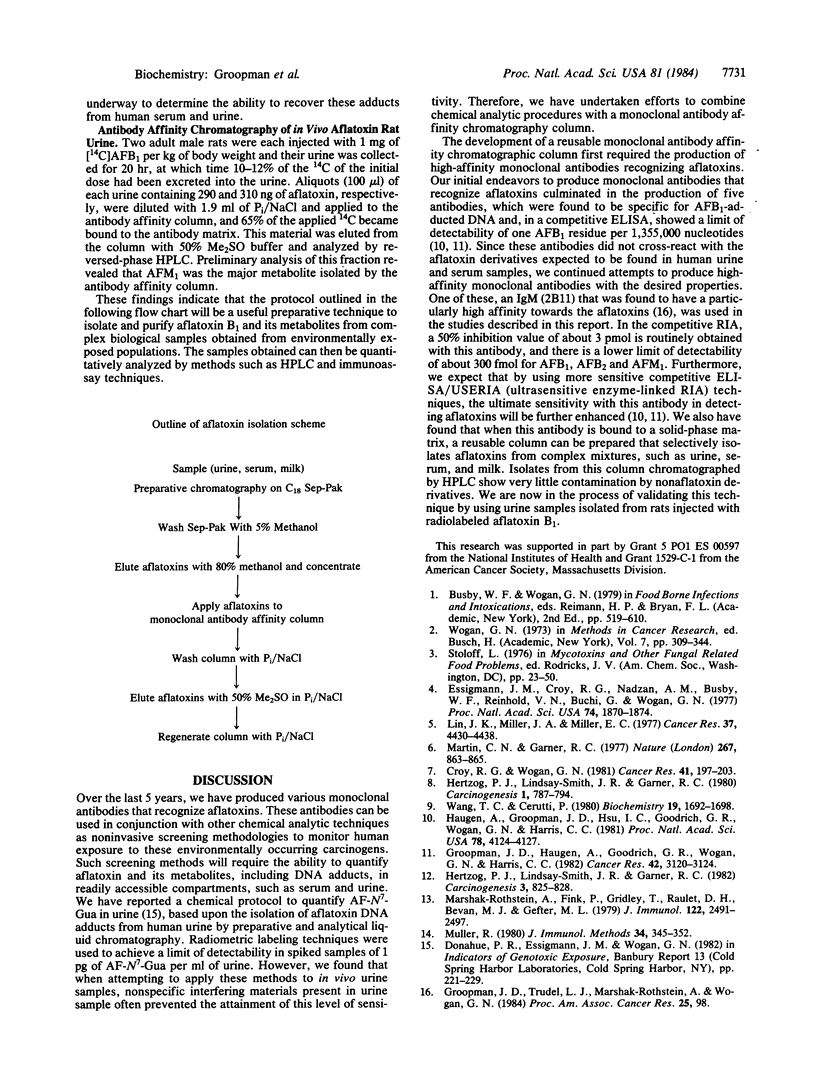Abstract
Monoclonal antibodies specific for aflatoxin B1, aflatoxin B2, aflatoxin M1, and the major aflatoxin-DNA adducts were obtained following fusion of mouse SP-2 myeloma cells with spleen cells of mice immunized with aflatoxin B1 covalently bound to bovine gamma globulin. The aflatoxin-modified protein used to immunize mice was produced chemically by activating aflatoxin B1 to a 2,3-epoxide derivative, which then covalently bound to the protein. One of the monoclonal antibodies isolated (2B11) was found to be a high-affinity IgM antibody with an affinity constant for aflatoxin B1, aflatoxin B2, and aflatoxin M1 of about 1 X 10(9) liters per mol. In a competitive radioimmunoassay using [3H]aflatoxin B1, 3 pmol (1 ng) of aflatoxin B1, aflatoxin B2, or aflatoxin M1 caused 50% inhibition with this antibody. The antibody also had significant cross-reactivity for the major aflatoxin-DNA adducts: 2,3-dihydro-2-(N7-guanyl)-3-hydroxyaflatoxin B1 and 2,3-dihydro-2-(N5-formyl-2',5', 6'-triamino-4'oxo-N5-pyrimidyl)-3-hydroxyaflatoxin B1. The antibody was also covalently bound to Sepharose-4B and used in a column-based solid-phase immunosorbent assay system. Aflatoxins added in vitro to phosphate buffer, human urine, human serum, or human milk at levels expected to be obtained in human samples acquired from environmentally exposed individuals were quantitatively recovered by applying the mixture to this antibody affinity column purification system. Preliminary studies using urine samples from rats injected with radiolabeled aflatoxin B1 have also indicated that aflatoxin metabolites can be isolated by these methods. Furthermore, we have found that the monoclonal antibody affinity columns can be regenerated for multiple use. Therefore, the monoclonal antibodies and their application to affinity chromatography represents a useful and rapid technique to purify environmentally occurring levels of this carcinogen and some of its metabolites for quantitative measurements.
Full text
PDF



Selected References
These references are in PubMed. This may not be the complete list of references from this article.
- Croy R. G., Wogan G. N. Temporal patterns of covalent DNA adducts in rat liver after single and multiple doses of aflatoxin B1. Cancer Res. 1981 Jan;41(1):197–203. [PubMed] [Google Scholar]
- Essigmann J. M., Croy R. G., Nadzan A. M., Busby W. F., Jr, Reinhold V. N., Büchi G., Wogan G. N. Structural identification of the major DNA adduct formed by aflatoxin B1 in vitro. Proc Natl Acad Sci U S A. 1977 May;74(5):1870–1874. doi: 10.1073/pnas.74.5.1870. [DOI] [PMC free article] [PubMed] [Google Scholar]
- Groopman J. D., Haugen A., Goodrich G. R., Wogan G. N., Harris C. C. Quantitation of aflatoxin B1-modified DNA using monoclonal antibodies. Cancer Res. 1982 Aug;42(8):3120–3124. [PubMed] [Google Scholar]
- Haugen A., Groopman J. D., Hsu I. C., Goodrich G. R., Wogan G. N., Harris C. C. Monoclonal antibody to aflatoxin B1-modified DNA detected by enzyme immunoassay. Proc Natl Acad Sci U S A. 1981 Jul;78(7):4124–4127. doi: 10.1073/pnas.78.7.4124. [DOI] [PMC free article] [PubMed] [Google Scholar]
- Hertzog P. J., Lindsay Smith J. R., Garner R. C. A high pressure liquid chromatography study on the removal of DNA-bound aflatoxin B1 in rat liver and in vitro. Carcinogenesis. 1980 Sep;1(9):787–793. doi: 10.1093/carcin/1.9.787. [DOI] [PubMed] [Google Scholar]
- Hertzog P. J., Smith J. R., Garner R. C. Production of monoclonal antibodies to guanine imidazole ring-opened aflatoxin B1DNA, the persistent DNA adduct in vivo. Carcinogenesis. 1982;3(7):825–828. doi: 10.1093/carcin/3.7.825. [DOI] [PubMed] [Google Scholar]
- Lin J. K., Miller J. A., Miller E. C. 2,3-Dihydro-2-(guan-7-yl)-3-hydroxy-aflatoxin B1, a major acid hydrolysis product of aflatoxin B1-DNA or -ribosomal RNA adducts formed in hepatic microsome-mediated reactions and in rat liver in vivo. Cancer Res. 1977 Dec;37(12):4430–4438. [PubMed] [Google Scholar]
- Marshak-Rothstein A., Fink P., Gridley T., Raulet D. H., Bevan M. J., Gefter M. L. Properties and applications of monoclonal antibodies directed against determinants of the Thy-1 locus. J Immunol. 1979 Jun;122(6):2491–2497. [PubMed] [Google Scholar]
- Martin C. N., Garner R. C. Aflatoxin B -oxide generated by chemical or enzymic oxidation of aflatoxin B1 causes guanine substitution in nucleic acids. Nature. 1977 Jun 30;267(5614):863–865. doi: 10.1038/267863a0. [DOI] [PubMed] [Google Scholar]
- Müller R. Calculation of average antibody affinity in anti-hapten sera from data obtained by competitive radioimmunoassay. J Immunol Methods. 1980;34(4):345–352. doi: 10.1016/0022-1759(80)90107-6. [DOI] [PubMed] [Google Scholar]
- Wang T. V., Cerutti P. Spontaneous reactions of aflatoxin B1 modified deoxyribonucleic acid in vitro. Biochemistry. 1980 Apr 15;19(8):1692–1698. doi: 10.1021/bi00549a027. [DOI] [PubMed] [Google Scholar]


